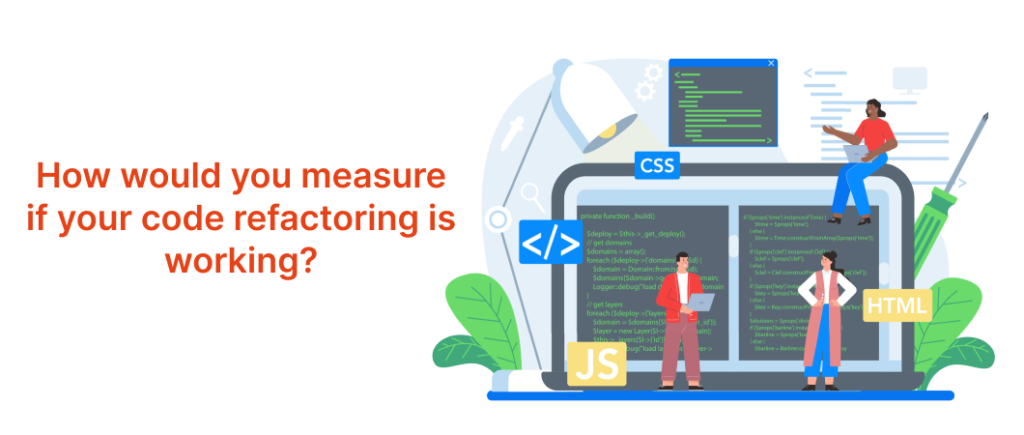Last updated on April 4th, 2024
Over the past few years, code refactoring has sometimes been discussed as the “silver bullet” for product development. And with good reason too! Especially in any Agile or DevOps environment, code refactoring is a near-universal priority. Refactoring is an essential practice to prevent code from “rotting” and to address technical debt.
That said, despite its many benefits, code refactoring has its share of risks. Depending on the complexity of the code, refactoring exercises can consume lots of time and be prone to human errors. For instance, “messy” code that is full of bugs cannot be refactored easily. An expert partner will tell you that it’s often better to rewrite the entire code.
Besides this factor, any refactored code will eventually become obsolete and will need refactoring once again. Despite all the extensive refactoring, no code is ever 100% perfect.
So, what are the acceptance criteria for refactoring in Agile development? How can product development measure the outcome of their refactoring process? We shall delve deeper to answer these questions in this blog.
What Is Continuous Refactoring?
Also referred to as “merciless refactoring,” continuous refactoring is the constant process of refactoring code to improve code design. With this practice, enterprises can easily extend their investments into software code assets and leverage business value for many years.
Continuous refactoring delivers an emergent software design such that it can continue to fulfill business requirements in the future.
Why Continuous Refactoring Should Be Part of Agile Development?
Here are some reasons why continuous refactoring should be part of any Agile development environment:
1. Enables Easier Modification to Running Code
When simply defined, code refactoring improves software design by treating any active application as a “moving target.” Regular refactoring increases cohesion (with new product functionalities) and makes it easier to modify code in any ongoing Agile project.
2. Embrace the Changes
Change management is an integral part of any Agile environment. Agile projects effectively require working in shorter iterations and releasing smaller chunks of functional code. Code refactoring is ideal for such an environment of continuous feedback, where it is not feasible to design the software in advance. Instead, continuous refactoring creates a product architecture that goes through continuous improvement and changes.
3. Understand the Codebase
Code sharing and communication are integral to any Agile project team. For effective team cooperation, code refactoring plays a critical role in developing a deeper understanding of the codebase.
As part of the refactoring “culture,” Agile teams may focus on the internal working of their code. However, they must demonstrate that their refactored code meets acceptance criteria.
What are the acceptance criteria for refactored code in Agile environments? Let’s discuss it next.
Acceptance Criteria for Code Refactoring in Agile
Along with user stories, defined acceptance criteria can resolve many ambiguities or problems in Agile code refactoring. An acceptance criterion is often the foundation for splitting refactoring based on stories and tasks.
Here are some metrics that Agile teams can use to meet the acceptance criteria for code refactoring:
1. Reduced Processing Time
Be it an Agile or any other environment, the primary aim of continuous refactoring is to reduce the code processing time (as compared to the previous benchmark). This acceptance criterion metric is possible as refactoring deals with smaller code chunks instead of the entire codebase in one go.
2. Zero Issues in the Codebase
If the number of open codebase issues keeps increasing, then it indicates declining code quality in the refactoring process. Ideally, every Agile sprint must aim to reduce the number of open codebase issues to zero (before moving to the next sprint).
Continuous refactoring helps in fixing smaller code issues before they become too complex to solve. Here are some effective ways to achieve zero codebase issues:
- Share codebase-related issues as team knowledge
- Prioritize codebase issues and monitor the progress
3. Zero Number of Failed Unit Tests
Besides issues, codebases also suffer from failed unit tests. In any Agile sprint, measure the success of code refactoring by monitoring the number of failed unit tests. Ideally, try to keep the number close to zero.
To improve the effectiveness and reliability of refactoring, incorporate practices like Behavior-Driven Development (BDD) and Test-Driven Development (TDD) in test automation. These practices help in creating many test cases.
4. Reduced Code Smell
A code smell is another useful metric in determining the success of code refactoring. As Martin Fowler puts it, code smells are not problematic on their own – but are warning signals to real problems in the code.
Depending on their granularity and impact, code smells are categorized as:
- Implementation smells
- Architecture smells
- Design smells
As a refactoring best practice, address each of these types of code smells to maximize the effectiveness of code refactoring.
5. Code Coverage
The code coverage metric is closely associated with the number of failed unit cases. This metric is effective in measuring the overall quality of any codebase. Higher code coverage translates into improved code quality.
To meet optimum code coverage and increase code trust, here are some measures:
- Cover the critical paths across the entire code
- Write, update, and modify tests when performing the refactoring
- Perform both code refactoring and testing in parallel
Conclusion
Code refactoring is essential for building reliable and resilient software products. Effective refactoring practices avoid common pitfalls and reduce technical debt.
At Forgeahead, we believe that refactoring is mandatory and recommend the best practices to our customers. Through continuous refactoring, Agile development companies can ensure the long-term health and relevance of their software products.
Want an accurate estimate for your next application development project? Let us help you with that. Talk to our software consultants today!



